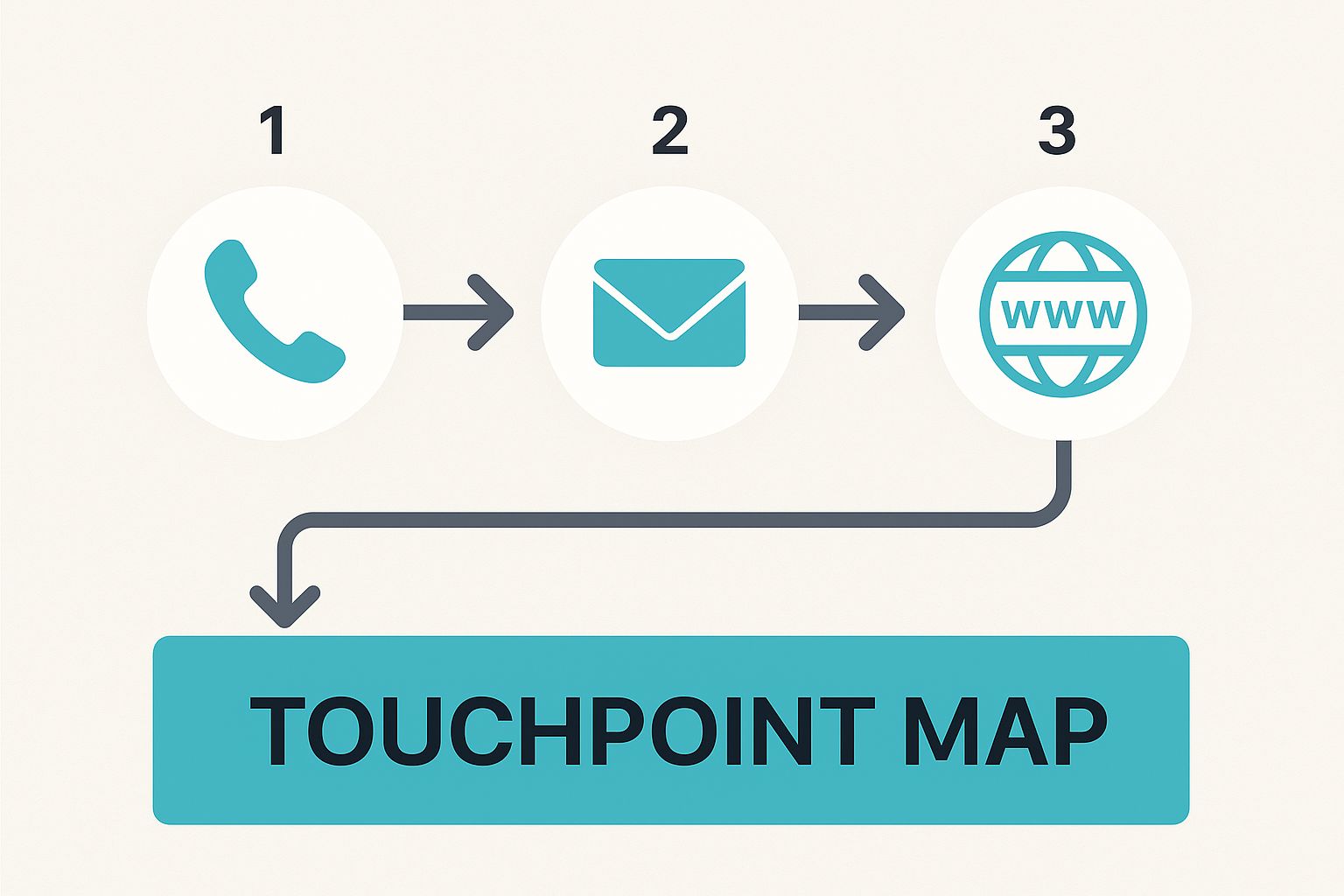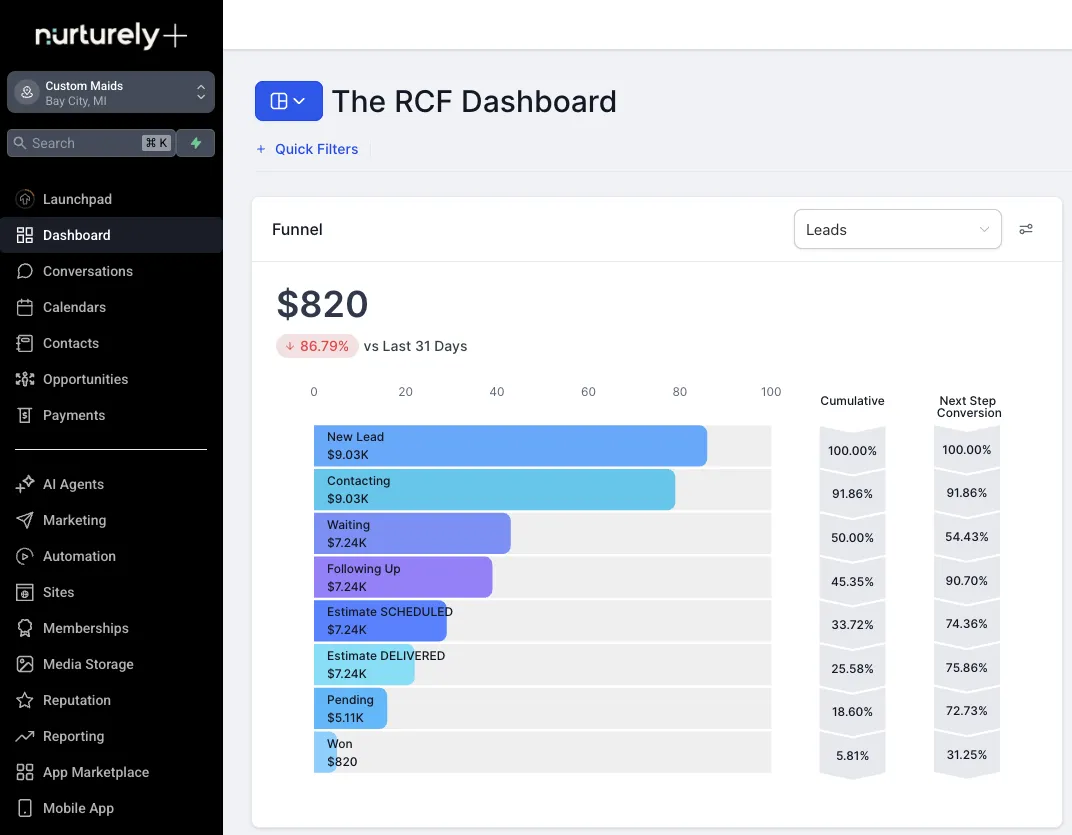How to Track Customer Journey
How to Track Customer Journey From Start to Finish
If you want to really understand your customer journey, you have to look beyond just the final sale. You need to see the whole picture—every single interaction someone has with your brand, from the moment they first hear about you until long after they've bought something. It's about mapping, monitoring, and then tweaking each stage to keep people around and grow your business.

TABLE OF CONTENTS
How to Track Customer Journey From Start to Finish
Why Bother Tracking the Customer Journey?
Boost Retention and Lifetime Value
Get a Serious Competitive Edge
Building a Journey Map With Real Customer Data
Combine Human Insight With Hard Data
Key Stages of the Customer Journey
Choosing Your Customer Journey Tech Stack
Evaluating Your Software Options
How to Analyze and Optimize Each Touchpoint
Identifying and Fixing Friction Points
Optimizing the Post-Purchase Experience
Overcoming Common Journey Tracking Challenges
Dealing With Disconnected Data Streams
Proving Your ROI to Leadership
Common Questions I Hear About Tracking the Customer Journey
How Often Should I Update My Journey Map?
What Is the Difference Between a User Flow and a Journey Map?
Why Bother Tracking the Customer Journey?
In today's market, knowing how and why customers choose you isn't a "nice-to-have" anymore. It's about survival. Just looking at your sales numbers at the end of the month gives you a tiny, incomplete piece of the puzzle. When you track the entire journey, you get the story behind the data. You start seeing the friction points, the "aha!" moments, and all the little opportunities you'd otherwise completely miss.
This perspective shifts you from just putting out fires to actually designing a better experience from the ground up. Instead of guessing what your customers want, you can watch what they do. This is the absolute foundation for building a business that doesn't just get new customers but turns them into loyal fans.
Boost Retention and Lifetime Value
When you map out the journey, you can pinpoint the exact actions and touchpoints that build loyalty. For example, you might find out that customers who watch a certain tutorial video are 30% more likely to buy from you again. Boom. Once you know that, you can start pushing that video to all your new users, directly impacting your retention rates.
A smooth, personalized experience, built on real data, is the new standard. The businesses that are absolutely crushing it are the ones focused on the entire journey, not just the final click to buy.
This intense focus on the customer experience is a huge driver of growth. In fact, the global customer journey analytics market is expected to hit a staggering USD 47.06 billion by 2032. Why? Because everyone's realizing that's where you maximize customer lifetime value.
Get a Serious Competitive Edge
Mapping the journey does more than just fix your own weak spots; it shines a light on your competitors' problems, too. It helps you see where they're dropping the ball and where you can double down on what makes you unique.
Understanding the different phases people go through, like the 5 stages of customer awareness, is key to making this work. Once you know exactly where a customer is in their decision-making process, you can deliver the perfect message at the perfect time. That kind of tailored approach builds a much stronger connection and makes your brand the no-brainer choice.
Building a Journey Map With Real Customer Data
Let’s be honest: a theoretical journey map is easy to make, but it’s rarely useful. If you want to effectively track the customer journey, you need a map that’s grounded in reality—built with data from your actual customers. Abstract models won't show you the real friction points that kill conversions, but human insights will.
The best place to start is with your key customer personas. Don't try to map every possible path at once. Instead, focus on your most valuable segments first. These are the people who will give you the clearest and most actionable insights.
Identify Your Key Personas
Who are your best customers? Seriously, who are they? Your first task is to identify specific, high-value groups whose journeys you truly want to understand. Keep it simple.
For an ecommerce business, a great starting point is to prioritize personas like recent first-time buyers or your most active loyalty program members. Their experiences are fresh, and they have a real, vested interest in your brand. Digging into their behaviors and motivations is where you'll find the gold. Shopify has some great thoughts on perfecting your ecommerce mapping that are worth a read.
This visual gives you a sense of how all those different digital touchpoints come together to shape a customer's experience.

A truly effective map acknowledges that the journey isn't a straight line. It’s more like a web of interconnected interactions happening across multiple channels.
Ask the Right Questions
Once you’ve zeroed in on your target persona, it’s time to get some qualitative data. This means actually talking to them through interviews or well-crafted surveys. Your mission is to uncover their motivations, their feelings, and their biggest pain points.
The most powerful insights come from asking why. Instead of "What did you buy?" ask "What problem were you trying to solve when you found us?" This simple shift uncovers the true emotional drivers behind their purchase.
Use open-ended questions to get people talking. Here are a few essential questions I always start with:
Initial Trigger: "What was going on in your life that made you start looking for a solution like ours?"
Research Process: "How did you go about researching your options? What websites, social channels, or other resources did you use?"
Alternatives Considered: "Which other companies did you look at, and what ultimately made you choose us (or not)?"
Decision Factors: "What was the single most important factor in your final decision?"
Combine Human Insight With Hard Data
Okay, the qualitative insights you get from interviews are powerful. But they become nearly unstoppable when you pair them with the quantitative analytics from your CRM and other tools.
Your interview might reveal a customer felt confused during checkout, and your analytics can come in right behind to confirm a 40% drop-off rate on that exact page. That's the magic moment.
This combination validates your findings and gives you the complete picture. You have the "what" from your data and the "why" from your customers. This dual-lens approach is the foundation of effective journey mapping, allowing you to build something that reflects reality, not just your team's assumptions. From here, you can pinpoint the exact areas for optimization and start creating a genuinely seamless experience.
To put this all together, it helps to have a clear framework. A good journey map always breaks the process down into distinct stages.
Here's a simple table outlining the typical stages, what the customer is trying to achieve in each, and the metrics you should be watching.
Key Stages of the Customer Journey

By tracking these metrics at each stage, you can see exactly where things are working and where they're breaking down. This turns your journey map from a pretty diagram into a powerful tool for growth.
Choosing Your Customer Journey Tech Stack
To really get a handle on the customer journey, you need more than just a map scribbled on a whiteboard. You need the right technology to bring that map to life, showing you exactly where people are, what they’re doing, and where they’re getting stuck.
Building a tech stack isn't about grabbing every shiny new tool you see. It's about putting together an integrated system that gives you one, single view of every customer interaction. Think of it as your command center.
Without it, you’re just guessing. You’re working with scattered data, making decisions based on half the story. A well-chosen stack connects all those dots, turning a mess of data into insights you can actually use.
The Core Components You Need
Your tech stack doesn't need to be crazy complicated. For most businesses, it really just boils down to three key pieces of software that work together to track, analyze, and improve the entire journey.
Customer Relationship Management (CRM): This is the heart of your operation. A solid CRM like Nurturely Plus is your central hub for all customer info, communication history, and sales activity. It’s where you manage the relationship, plain and simple.
Analytics Platforms: Tools like Google Analytics are your go-to for understanding website behavior. They show you where your traffic is coming from, which pages people are visiting, and how they’re moving through your site. This gives you the hard numbers behind your journey map.
Session Replay & Heatmap Tools: This is where things get interesting. These tools let you watch your website through your customers' eyes. Session recordings show you exactly what users are doing, what they're clicking on, and where they're getting frustrated. It’s the visual proof that analytics alone can't give you.
These three work together like a well-oiled machine. Analytics tells you what's happening, session replay shows you how it's happening, and your CRM ties it all back to a real person.
Evaluating Your Software Options
When you're picking your tools, the most important thing is how they talk to each other. A bunch of "best-in-class" tools that don't connect will just give you headaches and data silos.
Your goal isn't just to collect data; it's to create a seamless flow of information between your marketing, sales, and service teams. A truly integrated stack is what enables a consistent and personalized customer experience.
I've learned to evaluate any new software based on three non-negotiable standards:
Integration Capabilities: How easily does it plug into what you already use, especially your CRM? Look for native integrations first. They’ll save you a ton of time and keep your data clean.
Scalability: Will this tool grow with you? You don’t want something that’s going to fall over or cost a fortune once you start adding more customers and data.
Ease of Use: A tool is worthless if your team hates using it. Find software with a clean interface and good support. The faster your team can get in and start using it, the faster you'll see a return.
Honestly, this is why an all-in-one platform like Nurturely Plus often makes the most sense. It combines the CRM, marketing automation, and communication tools into one system right out of the box. This gets rid of most integration problems and ensures everyone on your team is working from the same playbook, making it far easier to track customer journey touchpoints from beginning to end.
How to Analyze and Optimize Each Touchpoint

Getting your customer journey mapped out and your tech stack in place is a massive win. Seriously, pat yourself on the back. But the map and the tools are just the starting line—the real magic happens when you start digging into each touchpoint to find the snags and uncover those hidden opportunities. This is where raw data turns into real, measurable growth.
Your goal here isn't just to glance at analytics reports and nod along. It's about connecting the numbers to what your customers are actually experiencing, then making a decisive move. This constant cycle of analysis and optimization is how you truly track customer journey performance over the long haul.
Think about it. Maybe you see a huge drop-off rate on your pricing page. A rookie move is just noting the number and moving on. The pro move is to dig in. You pull up some session replays and see people hovering over a specific feature description, looking confused, and then bouncing. Boom. That’s your signal to take action.
Identifying and Fixing Friction Points
Friction points are those little moments of pain where customers get stuck, confused, or just plain frustrated. They’re absolute conversion killers, but if you know how to spot them, they're also your single biggest opportunity for improvement.
One of the most classic friction points is cart abandonment. An unbelievable 70% of online shoppers ditch their carts before checking out. Why? The reasons are usually hiding in plain sight within the checkout process itself.
Your first job should always be to make key actions dead simple. Every extra field, every confusing step in your checkout is another excuse for a customer to walk away. Simplifying your forms can give you an instant, noticeable bump in conversions.
Let’s say you notice a huge number of people abandoning their cart right after the shipping info step. The data tells you what is happening, but you need to know why. By watching a few session recordings, you might find that your address validation tool is glitchy on mobile, causing a ton of frustration.
Armed with that insight, you can start testing solutions:
A/B Test a Simpler Form: Launch a version of your checkout with fewer required fields or switch to a more reliable address lookup service.
Show Shipping Costs Sooner: Nobody likes a surprise shipping fee. Test what happens when you display an estimated shipping cost directly on the product page.
Offer Guest Checkout: Forcing someone to create an account is a massive barrier. Adding a guest checkout option can slash your abandonment rate overnight.
Optimizing the Post-Purchase Experience
The journey doesn't stop once the credit card is charged. In fact, the post-purchase experience is where you earn loyalty and turn one-time buyers into repeat customers. Your support interactions are an absolute goldmine for this stage.
A great way to track and improve these interactions is by building a solid omnichannel messaging strategy. This keeps the experience smooth and consistent, whether a customer reaches out via email, live chat, or a social media DM.
Start by reviewing your support tickets. See a pattern? If you have dozens of tickets all asking, "Where's my order?" it’s a flashing red light that your post-purchase communication needs an overhaul. You could set up automated shipping notifications or build a self-service order tracking page. Small tweaks like these can make a huge difference in customer happiness and lighten the load on your support team. If you're looking for more ways to streamline this, it's worth exploring how to automate customer support without losing the human touch.
Turning Analysis into Action
Ultimately, analyzing touchpoints is about creating a feedback loop for continuous improvement. You use data to spot a problem, form a hypothesis about the cause, test a solution, and measure what happens. It's this rinse-and-repeat process that lets you refine your customer experience, one touchpoint at a time.
Overcoming Common Journey Tracking Challenges

Alright, so you're ready to start mapping the customer journey with your CRM. It’s an exciting step, but let's be real—it's not always a straight line. I’ve seen countless businesses hit the same few roadblocks right out of the gate.
The biggest one? The dreaded data silo. This is where your customer information is scattered across different departments, completely walled off from each other. Marketing has its analytics, sales lives in the CRM, and your support team has its own history of tickets and conversations.
When these systems can’t talk, you get a fractured picture. A customer might click a marketing email, have a great chat with a sales rep, and then contact support with a question. To your systems, that looks like three different people. Good luck tracking a journey with that kind of mess.
The only real fix is integration. Moving to an all-in-one platform where your marketing, sales, and support tools communicate instantly breaks down those silos. Every single touchpoint gets logged to one unified customer profile, giving you the complete, accurate story you need.
Dealing With Disconnected Data Streams
Even with an integrated system, you’ll run into another classic problem: trying to connect all your data streams in real time. Your customers are bouncing between your website, social media, email, and live chat without a second thought. Your tracking system needs to be just as agile.
This is a huge hurdle for a lot of companies. In fact, research points to the difficulty of integrating real-time data as a major pain point for professionals working to improve the customer experience. The same report also highlights that a more intelligent, dynamic approach is becoming essential. You can read the full research on the state of customer journey success to see just how common these challenges are.
My advice? Don't try to boil the ocean. Start by focusing on your most critical touchpoints first.
Website & CRM: Make sure every form submission and key page visit gets logged straight into your CRM. No exceptions.
Communication Channels: Funnel every email, live chat, and social media DM into a single inbox that’s tied directly to customer profiles.
Post-Purchase: Connect your payment or project management software to trigger automated follow-ups, like satisfaction surveys or onboarding sequences.
Build this solid foundation first. You can always tackle the more complex integrations later.
Proving Your ROI to Leadership
Finally, there’s the ultimate challenge: proving to leadership that all this work is actually worth it. Just telling them "we're improving the customer experience" won't cut it. You need to connect your efforts to what they really care about—the bottom line.
The most effective way to demonstrate value is to link journey improvements directly to key business metrics. Don't just report on activity; report on impact. Show leadership how your changes are moving the needle.
Let's say you streamlined your client intake process. Don't just report that you made a form shorter. Show them it led to a 20% increase in qualified leads and cut the time-to-quote by two days. A smoother new client onboarding process has a real, measurable impact on revenue.
When you frame your results in terms of reduced churn, higher customer lifetime value, and better conversion rates, you’re speaking their language. That's how you make a powerful case for investing in your journey tracking initiatives.
Of course, here is the rewritten section following your specific style and formatting requirements.
Common Questions I Hear About Tracking the Customer Journey
Look, even with the best plan in the world, once you start trying to track customer journey touchpoints in a real business, questions are going to pop up. It just happens.
Here are a few of the most common ones I get, with some straight-to-the-point answers to help you troubleshoot and keep moving forward.
How Often Should I Update My Journey Map?
This is a big one. The short answer: your journey map is a living document, not some static file you create and then bury in a folder somewhere. A good rule of thumb is to pull it out and give it a serious review at least every six months.
But here's the real-world caveat: you absolutely must revisit that map anytime you make a major change to your business. Launching a new product? Overhauling the website? Shifting your entire marketing focus? Each of those events demands a map update. Customer behavior isn’t set in stone, and your map can't be either if you want it to be useful.
What Is the Difference Between a User Flow and a Journey Map?
People get tangled up on this all the time, but the distinction is critical. They’re related, but they serve completely different purposes.
A User Flow is tactical. It's a micro-level map showing the literal steps someone takes to do one specific thing on your website or app. Think: the exact clicks from "Add to Cart" to the final "Thank You" page. It’s narrow and technical.
A Customer Journey Map is strategic. This is the big picture—the entire experience a customer has with your brand across every channel, both online and offline. It captures their feelings, their frustrations, and what’s driving them over a long period.
A user flow is a single chapter; a customer journey map is the whole book. One zooms in on a task, the other tells the entire story of your relationship.
How Can a Small Business Start Tracking the Journey?
You don't need a huge budget or a crazy-expensive tech stack to get started. Honestly, the most important thing is just to begin. Start small and focus on what actually moves the needle.
Kick things off with the free tools you're probably already using, like Google Analytics, to get a baseline for how people behave on your site. Then, go get direct feedback. It can be as simple as an email survey or, better yet, just picking up the phone and talking to a few of your most recent customers.
Pick one critical journey to map first—like the path from someone finding you on Google to making their first purchase. Once you've got that dialed in, then you can expand. The biggest mistake is getting paralyzed by complexity. Just start.
Ready to stop guessing and start seeing the complete customer journey? Nurturely Plus combines your CRM, marketing automation, and communication tools into one seamless platform. Break down data silos and get the unified view you need to turn strangers into loyal customers. See how Nurturely Plus can transform your business today.



